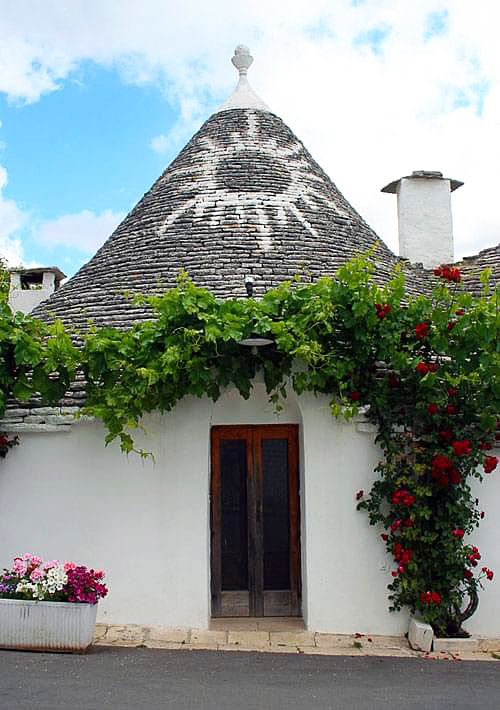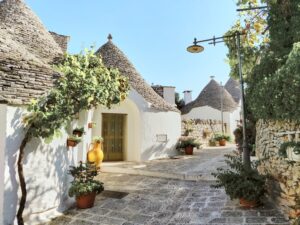
What’s the first thing that comes to your mind when you think of a place to visit in Italy? The odds are
that you did not mention the region of Puglia or its fairytale village of Alberobello. Most likely you would think of Rome, the canals of Venice, Pisa, and the sun-kissed rolling hills of Tuscany. Maybe the glamorous and glitzy Amalfi Coast crossed your mind? Like many tourists, you may have overlooked the beautiful region of Puglia. This region is also known as the “heel of the boot” has lots to offer and it is unspoiled by tourism and tourist crowds. Our article covers Puglia’s top tourist attraction. Let’s introduce you to Alberobello and its Trulli houses.
Here’s everything you need to know about the fairytale town of Alberobello
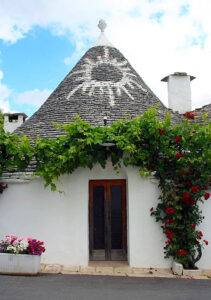
Alberobello is approximately 40 miles from the more known city of Bari. Alberobello means beautiful tree in Italian. The s town is located in the Puglia region also called Apulia. Present-day Alberobello began as a rural site of scattered settlements around 1000 AD. It has now transformed into two small districts.
They are the Rione Aia Piccola and Rione Monti. Rione aia Piccola is the most picturesque and less know to outside visitors. Rione Monti is the more popular place to see since it is home to hundreds of Trulli homes which many are still used as homes today. Alberobello has strived to preserve the authenticity and integrity of their peculiar prehistoric Trulli homes. The locals have embraced the Trulli homes and have made them part of their modern-day village. Many are private residences, hotels, restaurants, and even stores.
Prehistoric Hobbit Homes in Italy
So, what are Trulli huts? They are traditional hut-like houses with whitewashed stone walls and cone-shaped rooftops. The homes all have a simple shape that gives off a rural village vibe. These architectural details give them a very vintage appearance. Walking amidst Trulli-lined streets feels like a journey to a bygone era.
The History of Trullo & the Greek Connection
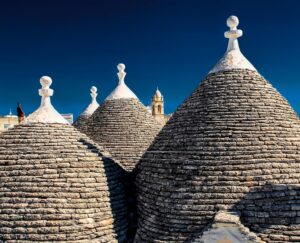
The origins of its cupola shape are debatable. The most common theory connects it with the Greek colonization of southern Italy. An article on National Geographic connects the dots in an enlightening cover story.
According to them, evidence suggests that early settlers were inspired by
the domed rooftops of Greek funeral chambers (i.e., Thalos). These conical constructions were prevalent during the 8th to 5th BC.
Secondly, the name itself is derived from the Greek word Trullo, meaning dome or cupola. UNESCO World Heritage supports this theory that the architectural design mimics the ‘dry-stone building tradition’ practiced across Greek-occupied Mediterranean regions. These dwellings began as scattered settlements in the rural regions of Greek conquests. They grew in numbers by the mid-14th century after the Crusades. In 1620, Gian Girolamo Guercio (the Guelph of Puglia) commercialized the settlements by introducing a Trullo bakery, mill, and inn. Construction stopped in 1797, when Ferdinand IV, Bourbon King of Naples, presided over the town and granted it the title of a ‘royal town.’ After this time, the construction of the new Trullo declined until it became a world heritage site in 1996. Some of the oldest Trulli in the area date back to the 14th century.
Architectural Details of Trullo
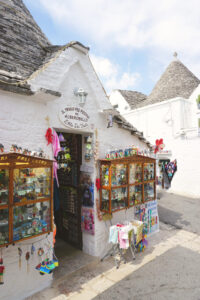
The reason for the building of hut-shaped homes remains unknown. However, there are various theories. Some historians believe that they were built as storage spaces and field shelters. Alternatively, others claim that they were private homes for peasants.
The fascinating aspect of these houses is the conical rooftops. Each roof features a roughly painted white symbol. These markings are varied designs, some having Christian connotations like crosses, Mary’s pierced heart, and letters representing saints.
Other symbols are more superstitious and have pagan interpretations like the evil eye or astrological signs. Rumor has it that these markings represent the class system present during the time. These days, it’s merely a trademark of the Trullo tradition and a fabulous place to spend the afternoon during a tour with us.

